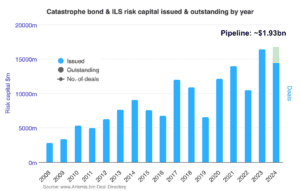What are the insurance trends to watch for in New Zealand this year?

Tough times
“Many New Zealand businesses are struggling,” declared W+K in the 15-page document seen by Insurance Business. “They are either still nursing a COVID-19 hangover or are battling the change in consumer habits caused by the lockdowns and remote working. They see no reprieve in the short-term outlook either, as consumer demand over the next 12 to 18 months is likely to decrease with the rising mortgage rates and money being spent overseas.
“We predict more audit negligence claims as insolvency impacts the worst affected businesses, particularly where desperate managers trade insolvent (or worse) and auditors face claims that they should have identified the breaches.”
Also expected to be at risk because of the difficult conditions in the country are employers, especially in the fields of hospitality and construction.
The insurance law firm predicted: “Economic and social issues will increasingly affect the workplace over the next two years. The Reserve Bank is currently forecasting recession for mid-2023. We predict claims for unjustified dismissal will increase as redundancies build and unemployment rises during the second half of 2023 and into 2024.
“Claims will likely initially affect the SME (small- and medium-sized enterprises), construction, and hospitality sectors. It is likely that financial pressures will result in more gig workers, contractors, and volunteers claiming employment status following the Employment Court’s findings that Uber drivers, a building contractor, and religious community members were employees.”
Aside from domestic economic woes, New Zealand is also likely to continue to be hit by shipping delays, long lead times, and port congestion, given its geographical ‘isolation’.
“Shipping routes to New Zealand may become less frequent as disruption results in shipping companies prioritising more profitable routes, which often involve core customers who are located closer to the exporters,” explained W+K.
“With delays and shortages, manufacturers may be tempted to use out-of-specification parts and ingredients more frequently. If they do, this will increase the risk of product recalls, product liability claims, and cross-border recovery issues.”
Cyber risk in shipping and IT
The shipping sector, meanwhile, is also faced with another problem – that of cyber piracy, which isn’t a specific Kiwi issue but one that threatens shipping companies around the world.
“With the increased interconnectivity between vessels and shore-based systems, use of automated systems, and the development of unmanned or autonomous vessels, the spectre of a significant physical damage loss at sea looms larger,” noted the insurance law firm.
“To date, most cyberattacks in the shipping industry have focused on onshore operations, but it is conceivable that cyber criminals could take control of vessels at sea. A common vulnerability is the industry’s generally low level of preparedness for cyber incidents, including low levels of risk awareness, ineffective procedures, and high levels of human error in offshore security breaches.”
Also in the firing line, cyber-wise, are information technology providers. We’ve seen this in the recent attack on health insurance cooperative Accuro’s IT infrastructure provider.
W+K said: “We will continue to see an increase in claims against IT professionals following cyber events, as well as a rise in software provider cyberattacks that result in more significant aggregation risk for insurers.
“Although these claims arise in several ways, we are likely to see more claims against managed services providers and cloud services providers that are responsible for hosting the data of their clients, and are themselves a victim of a cyberattack.”
Additionally, W+K is seeing an increased appetite for subrogated recoveries against IT professionals, as cyber insurers look to mitigate the costs of assisting policyholders.
Professional indemnity exposures
Another area to keep a close eye on is professional indemnity, not only for auditors, as mentioned above, but also with the likes of lawyers and accountants.
“From the 2022 income year, all eligible trusts in New Zealand are required to comply with the new financial reporting and disclosure rules,” stated W+K. “However, Inland Revenue can request disclosure back to the 2015 income year. The objective of the new rules appears to be to facilitate the collection of data regarding how New Zealanders are using trusts following the personal tax rate increase to 39% for taxpayers earning in excess of $180,000.
“It is likely that the government will share the data with overseas tax jurisdictions that it has a double tax agreement with. There are about 40 countries involved, including the USA, Australia, UK, India, Singapore, and Hong Kong. We expect ensuing investigations may lead to an increase in claims against accountants and lawyers who have been advising clients on tax efficiency.”
Claims related to capital gains tax are also forecast to surface, said W+K.
The law firm clarified: “New Zealand’s bright-line property rule has been in existence since October 2015. Since then, there have been low interest rates, which have attracted many property investors. Most of the $89 billion lent to residential property investors in the past one to three years has been fixed at historically low interest rates.
“However, in the next 18 months, between $44 and $67 billion will be coming off fixed-term mortgages and will be repriced at interest rates two to three times higher. This is likely to lead to an increase in claims against solicitors and accountants as investors are required to pay tax on any capital gains.”
Financial advisers, meanwhile, might come under the spotlight as well, following the Financial Markets Authority (FMA) – Te Mana Tātai Hokohoko’s probe into the use of the wholesale investor exclusion.
“The FMA found multiple instances of financial advisers confirming eligible investor certificates where there were no grounds to do so,” said W+K. “We predict that the FMA will start to refer more claims to the Financial Advisers Disciplinary Committee for breaches of the financial advisers’ Code of Professional Conduct.”
What other insurance trends do you expect to see this year? Share in the comments below.





